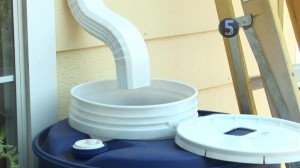This story is part of Earth911’s “Green Eight” series, where we showcase eight ways to green your life in various areas.
Spring evokes feelings of purity, freshness, growth and joy as we transition from the gloom of winter into the rays of summer’s sunshine.
But if you’re really looking to embrace the glory of spring, it won’t come without a little elbow grease. Here are our favorite eight ways to get the the most out of this upcoming green spring.
1. Lose Weight and Feel Great
It seems that during winter, you’re not the only one who might have “packed on the pounds.” Has your living space become inundated with items such as holiday gifts you’ll never use, magazines with recipes never cooked and chunky attire used to brave the elements? Lighten the load this spring by cleansing your living palette. You’ll have a fresh start and may feel a little lighter yourself.
While clutter-clearing, make it easier to sort items by creating four piles: Keep, Donation, Recycle and Trash.
- Keep: We often associate spring with fresh starts, but that doesn’t have to apply to everything. If your gardening spade and hoe are in tip-top shape, don’t buy brand new twinkling tools that you don’t need. This goes for all the items in your home. If they aren’t broken, why replace them?
- Donation: Taking an inventory of your belongings shows you that tastes change and upgrades happen - and, unfortunately, some of those “What was I thinking?!” moments as well. Even though items become disposable to you, they may have many useful miles left in their life cycles. Keep items out of overcrowded landfills by asking family and friends if they have use for any of your unwanted items. Your little sis who is moving into her own apartment, can make use of your old set of dishes, and Aunt Carol can use those extra muffin cups to bake for her next garden party. Anything leftover can be donated to local charities.
- Recycle: If your countertops and tabletops haven’t seen the light of day in weeks because they’re covered with books, magazines, catalogs and mail, then it’s time for a change. But, we don’t mean for you to heave everything into the wastebasket - recycle instead. Consider this: A family of four uses 1.25 tons of paper per year on average, and the U.S. EPA reports that recycling one ton of paper saves 3.3 cubic yards of landfill space, as well as enough energy to power the average American home for six months.
- Trash: Landfills should be used for items that truly have no other useful purpose. Be cautious when disposing of hazardous materials, as inappropriate distribution can cause toxic components to leach into the soil and groundwater.

Is a new season springing up around you? Help new growth by using earth-friendly practices. Photo: Deseretnews.com
2. Spring Cleaning
You weren’t the only one hiding from Old Man Winter this year. Dust, dirt and grime settled in also, and now it’s time to kick them to the curb. But be aware, some cleansers and polishes contain chemicals that can cause irritation to the skin, eyes, nose and throat, nausea, dizziness and other effects. Also, water used to rinse away their residue goes down the drain, carrying these ingredients with it. Less harmful ingredients exist in products from companies like Seventh Generation or Begley’s Best.
If you’re really feeling green, make your own cleaning products with vinegar, baking soda, lemon juice, borax and water. Also, cut back on paper towels and opt for a reusable cloth.
3. Deep Clean
Spring cleaning often goes beyond routine cleansing, dusting and vacuuming and involves home maintenance. One of the simplest things you can do to improve indoor air quality, while reducing energy bills, is replacing furnace filters on a monthly basis. Filters collect dirt and other particles so they don’t enter your living space, and when they are clogged, airflow decreases. Therefore, the furnace works harder - making it less energy efficient. Other ways to increase efficiency while spring cleaning are:
- Cleaning off coils on the back of your refrigerator to scatter heat away from the unit.
- Vacuuming clothes dryer ducts. Bob Vila created an excellent video if you haven’t performed this task before.
- Sealing gaps with weather-stripping or caulk around windows and doors to prevent warm air from entering your home.
- Checking out other comprehensive lists of home maintenance tips to make sure your home is ready for spring.
4. Dirty Laundry
After all that cleaning, it’s probably time to do a load of laundry. If you have an Energy Star washer, you’re cutting energy costs by 33 percent and water usage by 50 percent. If you don’t own one of these machines, then you can reduce costs by washing clothes in the coolest water possible.
According to the California Energy Commission, the dryer is the second biggest electricity-hogging appliance in the home. If you wish to lower energy costs, use the drying sensor, if the model has one, and regularly clean the lint trap. Or, you can forego drying altogether. Let nature do the job by switching to a clothesline or a drying rack.
5. Car Care
Having a car devoid of dirt and salt from winter conditions is a way to protect your investment, but if you do an at-home car wash, you may be doing more harm to the environment than you think. Water and contaminants from your vehicle flow freely down the driveway into the storm drain and into rivers, lakes and streams without first being treated. When washing cars at home, remember these tips provided by the Maryland Department of the Environment:
- Park on gravel or grass so soapy water soaks into the ground, becomes filtered and recharges groundwater.
- Use soap that does not say “harmful, danger or poison.” Try eco-friendly versions such as Simple Green’s products.
- Turn off the hose when you’re not using the water. During a 15-minute car wash, you could use 150 gallons of water if there isn’t an automatic shut-off nozzle.
- If you’re out doing errands already, stop by a commercial car wash, which is connected to a sanitary sewer whereby dirty water is carried to a treatment plant. Newer facilities may also recycle 10-80 percent of their wastewater for an additional environmental benefit.
6. Rainwater Preservation
Springtime brings more rain-showers than most of us can handle, but come mid-summer, gardeners and lawn-care enthusiasts usually end up praying for rain. It seems like such a waste to have excess water one month and a shortage another. Luckily, rainwater harvesting has gone mainstream, and it’s easy for homeowners to take advantage of recapturing “lost” water with a rain barrel. Your roof collects rainwater and funnels it through gutters or downspouts, where it can be collected. But be sure to leave room to provide easy access the spigot. When your plants need a drink, just use the water from the barrel instead of turning on the hose.
7. Green Thumb
Now that you’ve side-stepped hydration issues with your lawn and garden, you’ll need to take care of other problems like weeds and bugs:
- Weeds: Instead of using herbicides that leach chemicals into the soil and end up in water runoff, pull weeds by hand or saturate them with vinegar. If you do use herbicides, be sure to make sure you properly dispose of their containers or any excess liquids once you’re done.
- Bugs: Give them a sharp spray with water, and if that doesn’t work, try an insecticide soap. Mix one gallon of water with three tablespoons of liquid dish soap, and spray on both sides of plant leaves to deter insects.
8. Get Ready for Grilling
Now that you’ve tackled all of your spring projects, kick back, relax, and enjoy the fruits of your green labor. You’ve worked hard, so reward yourself with a treat from the grill.
Natural gas and electric grills have the least negative impact on the environment, especially if you recycle your propane tank when finished. For those of you who believe grilling isn’t grilling unless it’s done over charcoal, consider that it releases greenhouse gases and soot particles. If you just can’t live without this smoky flavor, look for eco-friendly alternatives to charcoal briquettes such as those that use recycled coconut husk waste or have the Forest Stewardship Council or Rainforest Alliance SmartWood certification logo.

Kasen Seaver
Kasen Seaver is a freelance writer for Earth911, and enjoys putting her knowledge of eco-conscious living into practice.
